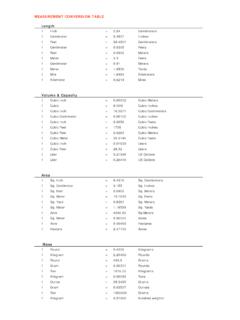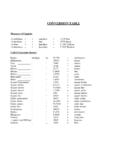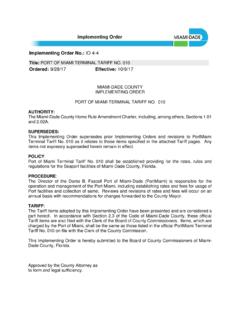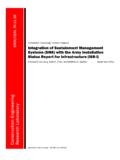Transcription of Los Alamos Radiation Monitoring Notebook
1 Los Alamos Radiation Monitoring Notebook LA-UR-00-2584. James T. (Tom) Voss, NRRPT, CHP. June 2000 (Feb. 2001 Update). table OF CONTENTS. Page #. Abbreviations 3. conversion of Units 4 7. Constants 7-8. Rules of Thumb 8 - 16. Units and Terminology 17. Radiation Interactions 18. Public Radiation Dose Rates 19. Radon Facts 20. Biological Effects of Radiation 21. Dosimetry 22 - 24. Equivalent Dose, Effective Dose, and Committed Effective Dose 25. Radiation Weighting Factors 26. Calculating TODE and TEDE 27. Effects of Radiation Exposure 28. table of the Elements 29 - 30. Radioactive Decay Chart 31 - 32. Reporting Radiological Data 33. Surface Contamination Correction Factors 34 - 35. Detector Efficiency 36. Alpha & Beta Crosstalk 36. Correction Factors for Efficiency 36. Inverse Square Law 37. Shallow Dose Correction Factors 37. Stay-Time Calculations 37.
2 Calculating Exposure Rate in an Air-Filled Ionization Chamber 38. Calculating Percent Resolution of a Gamma Spectroscopy Detector 38. Calculating True Count Rate Based on Resolving Time of a Gas-Filled Detector 38. Calculating Gamma-Ray Constant 39. Calculating Photon Fluence Rate from a Point Source 39. Calculating Exposure Rate from a Point Source 39. Page 1. table OF CONTENTS. Page #. Calculating Dose Rate to air from a Point Beta Source 39. Calculating Exposure Rate from a Line Source 40. Calculating Exposure Rate from a Disk Source 40. Calculating 6 CEN 40. Calculating Airborne Radioactivity 41. Respiratory Protection Factors 41. Air Monitoring Calculations 42 - 44. Surface Area Calculations 45. Volume Calculations 46. Gamma & Neutron Half-Value Layers 47. Shielding Calculations 48 - 50. Shielding Materials 51. Calculating Transmission Factor (X-ray) 51.
3 Density of Various Materials 52. Radioactive Decay Graphs 53 - 54. table 1 of DOE 55. Appendix D of 10 CFR835 56. Posting 57 - 58. Instrument Use and Selection 59 - 60. DOT 49 CFR173 61 - 62. Specific Activity 63 - 64. Characteristic Radiations of Radionuclides 65 - 72. Specific Activity vs. Radiation Levels 73 - 76. Gamma Exposure vs. Particle Size 77 - 78. Ingestion and Inhalation ALIs 79 - 86. Activity vs. Particle Size 87 - 88. Emergency Response 89 - 92. Facility Hazards 93. Thorium-232 and Uranium-238 Decay Chains 94 - 96. Calendar Years 2001 and 2002 97 - 98. Alphabetical Index 99 - 100. Page 2. ABBREVIATIONS. ampere A, or amp angstrom unit D, or A. atmosphere atm atomic weight at. wt. cubic foot ft3, or cu. Ft. cubic feet per minute ft3/min, or cfm cubic inch in3, or cu. in. cubic meter m 3, or cu. m. curie Ci day day, or d degree deg, or 0.
4 Disintegrations per minute dpm foot ft. gallon gal. gallons per minute gpm hour h, or hr inch in. liter L. meter m micron , m, or mu minute min, or m pounds per square inch lb/in2, or psi roentgen R. second sec, or s square centimeter cm 2, or sq cm square foot ft2, sq ft square meter m 2, or sq m volt V, or v watt W, or w year yr, or y Page 3. conversion OF UNITS. Multiply by To Obtain To Obtain by Divide Length Angstroms 1 E-8 centimeters Inches centimeters meters feet kilometers miles miles 5280 feet microns ( m) 1 E-6 meters mils 1 E-3 inches Area Acres 43,560 square feet Barns 1 E-24 square centimeters Square centimeters square inches Square meters square feet Square meters E-7 square miles Square miles 640 acres Volume Cubic centimeters E-5 cubic feet Cubic centimeters 1 E-6 cubic meters Cubic feet liters Cubic feet gallons Liters quarts Liters gallons Cubic meters cubic feet Cubic meters 1,000 liters Milliliters 1 cubic centimeters Page 4.
5 conversion OF UNITS. Multiply by To Obtain To Obtain by Divide Time days 1440 minutes days 86,400 seconds work week E5 seconds work month work weeks work month work hours years (calendar) 365 days years 8,760 hours years E5 minutes years E7 seconds Density grams / cm3 pounds / cubic foot grams / cm3 pounds / gallon Pressure atmospheres bars atmospheres 1,033 grams / cm2. atmospheres pounds / atmospheres 760 mm Hg @ 0 0C. atmospheres inches Hg @ 32 0F. atmospheres feet H2O @ 0F. bars 1 E6 dynes / cm2. dynes / cm2 E-3 grams / cm2. grams / cm2 pounds / square inch Torr 1 mm Hg @ 0 0C. Energy ergs E11 electron volts ergs E-8 gram calories electron volts E-12 ergs Page 5. conversion OF UNITS. Multiply by To Obtain To Obtain by Divide Mass grams ounces kilograms pounds pounds 16 ounces pounds grams Others amperes E9 electrostatic units / sec amperes E18 electronic charges / sec coulombs E18 electronic charges radians degrees Radiological rads 100 ergs / gram rads E13 electron volts / gram roentgens ergs / gram of air roentgens E12 ion pairs / gram of air roentgens E13 electron volts / gm of air sievert 100 rem curies E10 dps curies E12 dpm curies / sq.
6 Meter 220 dpm / cm 2. megacuries / sq. mile curies / square meter 3. dpm/m E-13 microcuries / cm 3. bequerels E-11 curies bequerels 1 dps BTU E-8 grams 235U fissioned BTU E-8 grams 235U destroyed BTU E13 fissions fission of 1 g 235 U 1 megawatt-days fissions E-18 kilowatt-hours fissions E-4 ergs Page 6. conversion OF UNITS. Multiply by To Obtain To Obtain by Divide Power joules/sec 1 E7 ergs / second watts 1 E7 ergs / second watts horsepower watts E10 fissions / second MULTIPLES AND SUBMULTIPLES. 12. 10 tera T 10-1 deci d 109 giga G 10-2 centi c 106 mega M 10-3 milli m 103. kilo k 10 -6. micro . 2 -9. 10 hecto h 10 nano n 1 -12. 10 deka da 10 pico p 100 1 1 10-15 femto f 10-18 atto a GREEK ALPHABET. Alpha Nu Beta Xi Gamma Omicron Delta Pi Epsilon Rho Zeta Sigma Eta Tau Theta Upsilon Iota Phi Kappa Chi Lambda Psi Mu Omega Page 7. CONSTANTS.
7 Avogadro's number (N0) E23. electron charge (e) E-10 esu electron rest mass (m e) E-28 g acceleration gravity (g) ft / sec 2. @ sea level & 450 latitude cm / sec 2. Planck's constant (h) E-27 erg-sec velocity of light (c) E10 cm / sec velocity of light (c) 186,280 miles / sec ideal gas volume (V0) 22,414 cm3 / mole (STP). neutron mass E-24 g proton mass E-24 g ratio of proton to electron mass 1, natural base of logarithms (e) A gram-molecular weight of any gas contains (Avogadro's number), N0 ( E23). atoms and occupies a volume of 22,414 cm3 at STP. Temperature 0 0 0. C = ( F - 32)(5/9) F = 0C + 32. 0. K = 0C + 0. R = 0F + conversion Equations grams/sq. cm = density (g/cm3) x thickness (cm). Photon energy (keV) = (A). Page 8. RULES OF THUMB FOR ALPHA PARTICLES. 1. An alpha particle of at least MeV energy is needed to penetrate the nominal protective layer of the skin (7 mg / cm2 or mm).
8 2. The alpha emissions and energies of the predominant particles from 1 g of several common materials are: DPM per g Alpha Energy (MeV). 238. Pu 39,000,000 (72%). 239. Pu 140,000 ( ). 240. Pu 500,000 (76%). 242. Pu 8,700 (76%). a Natural U (37%), (36%). Oralloy (93% 235U) 160 (~ 80%). b Natural Th (38%), (36%). D-38 (DU, tuballoy) 1 (~ 60%). a Includes 234U in equilibrium. b Includes 228Th in equilibrium. Depending upon the time since chemical separation, 228. Th can decrease to give a net disintegration rate lower than c. With 2 (50%) geometry, the surface of a thick uranium metal (tuballoy) source gives ~ 2400 alpha counts/min per cm2. Depleted uranium (D-38) gives ~ 800 alpha cpm/cm 2. 3. Alpha particle range in cm of air at 1 atmosphere Ra = E (E <4 MeV). Ra = E - (E > 4 MeV). Alpha particles lose about 60 KeV of energy per mm of air at 1 atmosphere.
9 Page 9. RULES OF THUMB FOR ALPHA PARTICLES. 4. Detector window thicknesses cause alpha particles to lose energy at about 1 MeV per mg/cm 2 of window thickness. Therefore, a detector with a window thickness of 3 mg/cm 2. (such as sealed gas-proportional pancake alpha/beta detectors and pancake GM. detectors) will not detect alpha emitters of less than 3 MeV . These detectors will have very low efficiency for low energy alpha particles or attenuated alpha particles. 5. Air proportional alpha particles have a flatter energy vs efficiency response than gas- proportional or GM detectors. 6. Half-value thickness vs alpha energy A. For surface alpha contamination first determine an unshielded net count rate (subtract background) with your instrument. B. Place a sheet of mylar between the source and the detector and take another net reading. Some typical thickness of mylar are , , , and mg/cm2.
10 C. Calculate the half-value density thickness by using this formula. mg / cm 2 = mg / cm2 of the mylar x ln (shielded net count rate / unshielded net count rate). Note: make sure to take the natural log of the count rates D. Approximate the alpha energy in MeV by using this formula. MeV = x thickness from C'. Page 10. RULES OF THUMB FOR BETA PARTICLES. 1. Beta particles of at least 70 keV energy are required to penetrate the nominal protective layer of the skin (7 mg / cm2 or ). 2. The average energy of a beta-ray spectrum is approximately one-third the maximum energy. 3. The range of beta particles in air is ~ 12 ft / MeV. 4. The range of beta particles (or electrons) in grams / cm 2 (thickness in cm multiplied by the density in grams / cm 3) is approximately half the maximum energy in MeV. This rule overestimates the range for low energies ( MeV) and low atomic numbers, and underestimates for high energies and high atomic numbers.








